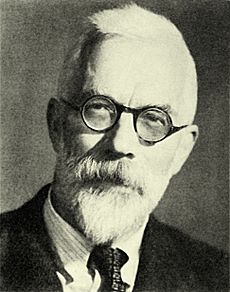Modern evolutionary synthesis facts for kids
The modern evolutionary synthesis is about evolution. It explained how the discoveries of Gregor Mendel fit with Charles Darwin's theory of evolution by means of natural selection. Mendel found out how we inherit our genes.
Contents
The people
Key biologists who contributed work to the synthesis included: Julian Huxley, Theodosius Dobzhansky, Ernst Mayr, Ronald Fisher, J.B.S. Haldane, Sewall Wright, G.G. Simpson, E.B. Ford, Bernhard Rensch and G. Ledyard Stebbins.
The theory
The modern synthesis brought Darwin's idea up to date. It bridged the gap between different types of biologists: geneticists, naturalists, and palaeontologists.
It states that:
- Evolution can be explained by what we know about genetics, and what we see of animals and plants living in the wild.
- The variety of genes (alleles) carried in natural populations is a key factor in evolution.
- Natural selection is the main mechanism of change. Even a very slight advantage can be important, continued generation after generation. The struggle for existence of animals and plants in the wild causes natural selection. Only those who survive and reproduce pass their genes on to the next generation.
We find the strength of natural selection in the wild was greater than even Darwin expected. - Evolution is gradual: natural selection occurs, and small genetic changes collect. Species only change little from one generation to the next. Big changes do occur, from time to time, but they are very rare.
- Genetic drift is usually less important than natural selection. It can be important in small populations.
- In palaeontology, we try to understand the changes in fossils through time. We think the same factors which act today also acted in the past.
- As circumstances change, the rate of evolution may get faster or slower, but the causes are the same.
The idea that new species occur after populations split has been much debated. Geographical isolation often leads to speciation. In plants, polyploidy must be included in any view of speciation.
- "Evolution consists mainly of changes in the frequencies of alleles between one generation and another".
This shows how some biologists see the synthesis.
Almost all aspects of the synthesis have been challenged at times, with varying degrees of success. There is no doubt, however, that the synthesis was a great landmark in evolutionary biology. It cleared up many confusions, and was directly responsible for stimulating a great deal of research after WWII.
After the synthesis
There are a number of discoveries in earth sciences and biology which have arisen since the synthesis. Listed here are some of those topics which are relevant to the evolutionary synthesis, and which seem soundly based.
Understanding of Earth history
The Earth is the stage on which the evolutionary play is performed. Darwin studied evolution in the context of Charles Lyell's geology, but we now know more about Earth history.
- The age of the Earth has been revised upwards. It is now estimated at 4.56 billion years, about one-third of the age of the universe. The Phanerozoic only occupies the last 1/9 of this time.
- The triumph of Alfred Wegener's idea of continental drift came around 1960. The key principle of plate tectonics is that the lithosphere exists as separate and distinct tectonic plates, which ride on the fluid-like (visco-elastic solid) asthenosphere. This discovery provides a unifying theory for geology, linking phenomena such as volcanos, earthquakes, orogeny, and providing data for many paleogeographical questions. One major question is still unclear: when did plate tectonics begin?
- Our understanding of the evolution of the Earth's atmosphere has progressed. The substitution of oxygen for carbon dioxide in the atmosphere occurred in the Proterozoic. It was probably caused by cyanobacteria, whose colonies fossilised as stromatolites. The oxygenation of the atmosphere lead to the evolution of aerobic organisms. It led also to the first great ice ages.
- The identification of the first generally accepted fossils of microbial life was made by geologists. These rocks have been dated as about 3.465 billion years ago. Walcott was the first geologist to identify pre-Cambrian fossil bacteria from microscopic examination of thin rock slices. He also thought stromatolites were organic in origin. His ideas were not accepted at the time, but may now be appreciated as great discoveries.
- Information about palaeoclimates is increasingly available, and being used in paleontology. One example: massive ice ages occurred in the Proterozoic, following the great reduction of CO2 in the atmosphere. These ice ages were immensely long, and led to a crash in microflora. See also Cryogenian period and Snowball Earth.
- Catastrophism and mass extinctions. A partial reintegration of catastrophism has occurred, and the importance of mass extinctions in large-scale evolution is now apparent. Extinction events disturb relationships between many forms of life and may remove dominant forms and release a flow of adaptive radiation amongst groups that remain. Causes include meteorite strikes (K–T junction; End–Ordovician extinction events); flood basalt provinces (Deccan Traps at K/T junction; Siberian Traps at P–T junction); and other less dramatic processes.
Conclusion: Our present knowledge of earth history strongly suggests that large-scale geophysical events influenced macroevolution and megaevolution. These terms refer to evolution above the species level, including such events as mass extinction, adaptive radiation, and the major transitions in evolution.
Fossil discoveries
In the past thirty or so years there have been excavations in parts of the world which had scarcely been investigated before. Also, there is fresh appreciation of fossils discovered in the 19th century, but then denied or deprecated. Many outstanding discoveries have been made, and some of these have implications for evolutionary theory.
- The discovery of the Jehol biota: dinobirds and early birds from the Lower Cretaceous of Liaoning, N.E. China. This shows that birds did evolve from coelurosaurian theropod dinosaurs.
- Studies on stem tetrapods from the Upper Devonian.
- The early stages of whale evolution.
- The evolution of flatfish (pleuronectiformes), such as plaice, sole, turbot and halibut. Their young are perfectly symmetrical, but the head is remodelled during a metamorphosis. One eye moves to the other side, close to the other eye. Some species have both eyes on the left (turbot), some on the right (halibut, sole); all living and fossil flatfish to date show an 'eyed' side and a 'blind' side. Darwin predicted a gradual migration of the eye in evolution, mirroring the metamorphosis of the living forms.
A recent examination of two fossil species from the Eocene shows "the assembly of the flatfish bodyplan occurred in a gradual, stepwise fashion". The intermediate stages were fully viable: these forms ranged over two geological stages, and are found in sites which also yield flatfish with the full cranial asymmetry. The evolution of flatfish falls squarely within the evolutionary synthesis.
Evo-devo
Important work on genetics has led to a new approach to animal development. The field is called evolutionary developmental biology, or evo-devo for short.
There is clear proof that much of development is closely controlled by special genetic systems involving hox genes. In his Nobel Prize lecture, E.B. Lewis said "Ultimately, comparisons of the [control complexes] throughout the animal kingdom should provide a picture of how the organisms, as well as the [control genes] have evolved".
In 2000, a special section of the Proceedings of the National Academy of Sciences (PNAS) was devoted to evo-devo, and an entire 2005 issue of the Journal of Experimental Zoology Part B: Molecular and Developmental Evolution was devoted to the key evo-devo topics of evolutionary innovation and morphological novelty.
A survey of the field for the general reader gives examples.
Relevant pages






